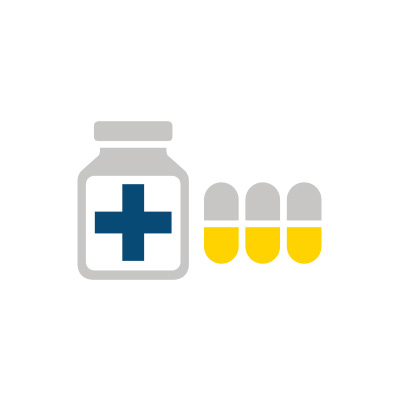Pharma
Products for pharma applications from abcr


We offer our customers a vast assortment of various substance classes for the pharma area, ranging from antibiotics to biopharmaceuticals and building blocks. This product range is used both in the pharmaceutical industry as well as in medical research as these sectors of the healthcare system rely on Gute Chemie. Their service portfolios encompass production, testing and distribution of pharmaceutical preparations as well as research and development of new active agents and treatment forms.
Medical chemistry represents the scientific and methodical basis. This interdisciplinary subsection of chemistry deals with the design, synthesis, analytics and (further) development of pharmaceuticals and medical excipients as well as their underlying modes of action and structure-activity relationships. Thus, medical chemistry bridges the gap between (synthetic) organics and other areas of natural science such as pharmaceutics or biochemistry.
It has become impossible to imagine medicine and research without the active agent class of antibiotics. Antibiotics are of prominent importance in combatting bacterial infections. However, their usage has also established itself in other areas, for example as a selection marker in molecular-biological methodology. Antibiotics can either have a bacteriostatic (growth-inhibiting) or bactericidal (killing) effect. The underlying modes of action are multi-layered. For example, the group of tetracyclines blocks the protein biosynthesis specifically at bacterial ribosomes and thereby prevents the growth of germs. In contrast, active agents of the penicillin class intervene in the cell wall synthesis and thereby lead to the lysis of bacteria.
The product class of phospholipids is used in various ways in pharmaceutical production. Its application potential ranges from so-called excipients to a direct therapy approach. For example, phospholipids can improve the absorption of a medication into the body or at the action site or reduce the toxicity of an active agent.
An important group of innovative pharmaceuticals with great potential is gaining more and more importance in modern medicine: biopharmaceuticals. These are most often produced in highly complex procedures based on biotechnological methods and GMOs (genetically modified organism). Based on their biological functionality, biopharmaceuticals make it possible to specifically intervene in complex bodily processes. Important active agent groups in which biopharmaceuticals are already used today include vaccines, hormones and therapeutic antibodies, also for cancer therapy.
Since the end of the 1900s, the pharmaceutical industry in particular has been intensively using building blocks for researching pharmaactive agents. Building blocks often function like “libraries”, i.e. as a carefully chosen selection of a few hundred to thousand building blocks for screening new active agents.
Building blocks are synthesis building blocks and most often have one or multiple functional groups. Moreover, they are linked to other synthesis building blocks: Heterocyclic core structures such as pyridine, pyrrolidine or thiophene can be substituted with functional groups such as alcohols, aldehydes, carbonic acids, amines, amides, sulphonic acids, boronic acids, anhydrides, esters, nitriles, nitro compounds, diazo compounds, cyanates, isocyanates, alkenes, alkines or fluorine-containing groups.
Methods from combinatorial chemistry allow for the parallel synthesis of a multitude of similarly structured molecules. Suitable reaction conditions can cause building blocks to react in a targeted manner with high yields.
The introduction of fluorine substitutes in active agents has proven exceptionally advantageous. Pharmacokinetic properties can thereby be improved.
Buildings blocks in the abcr catalogue – find your desired molecule
Our unique building blocks for medical chemistry include
- linked amino acids,
- special chiral building blocks and
- more than 80,000 fluorine-substituted products.
The abcr catalogue offers a choice of more than 200,000 building blocks.

